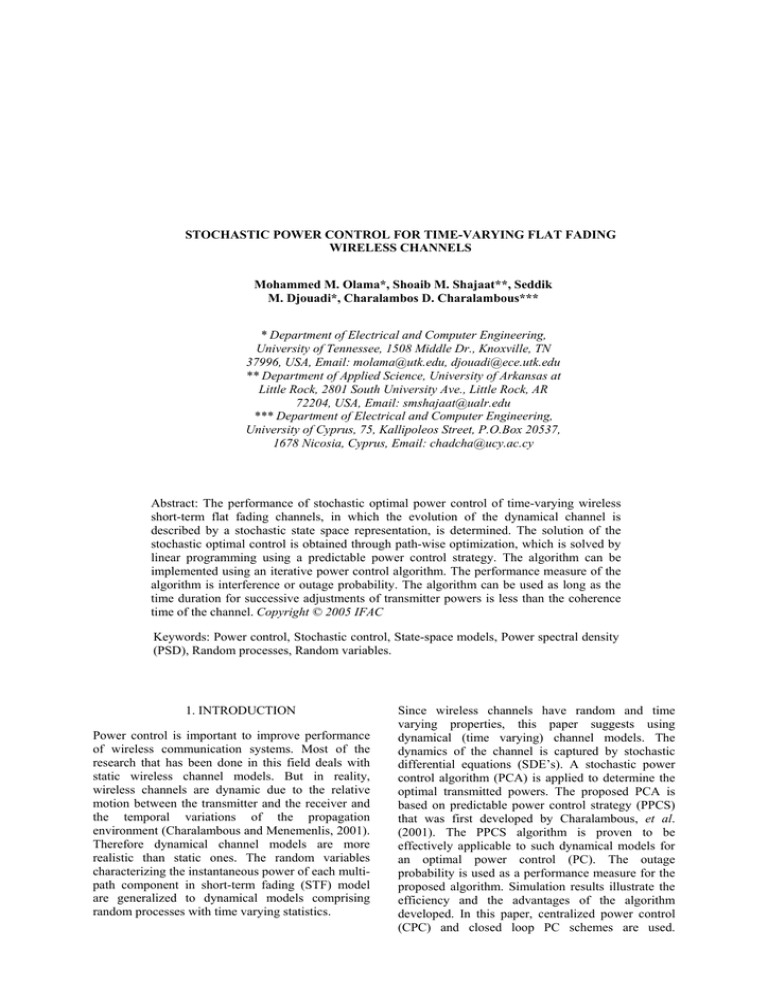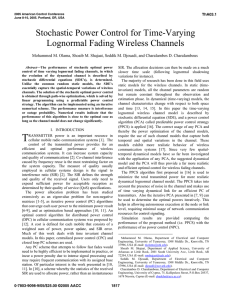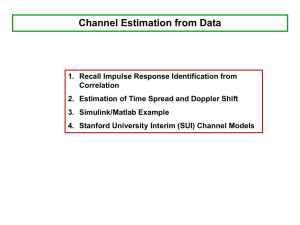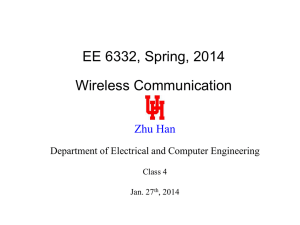Document 11901352
advertisement

STOCHASTIC POWER CONTROL FOR TIME-VARYING FLAT FADING
WIRELESS CHANNELS
Mohammed M. Olama*, Shoaib M. Shajaat**, Seddik
M. Djouadi*, Charalambos D. Charalambous***
* Department of Electrical and Computer Engineering,
University of Tennessee, 1508 Middle Dr., Knoxville, TN
37996, USA, Email: molama@utk.edu, djouadi@ece.utk.edu
** Department of Applied Science, University of Arkansas at
Little Rock, 2801 South University Ave., Little Rock, AR
72204, USA, Email: smshajaat@ualr.edu
*** Department of Electrical and Computer Engineering,
University of Cyprus, 75, Kallipoleos Street, P.O.Box 20537,
1678 Nicosia, Cyprus, Email: chadcha@ucy.ac.cy
Abstract: The performance of stochastic optimal power control of time-varying wireless
short-term flat fading channels, in which the evolution of the dynamical channel is
described by a stochastic state space representation, is determined. The solution of the
stochastic optimal control is obtained through path-wise optimization, which is solved by
linear programming using a predictable power control strategy. The algorithm can be
implemented using an iterative power control algorithm. The performance measure of the
algorithm is interference or outage probability. The algorithm can be used as long as the
time duration for successive adjustments of transmitter powers is less than the coherence
time of the channel. Copyright © 2005 IFAC
Keywords: Power control, Stochastic control, State-space models, Power spectral density
(PSD), Random processes, Random variables.
1. INTRODUCTION
Power control is important to improve performance
of wireless communication systems. Most of the
research that has been done in this field deals with
static wireless channel models. But in reality,
wireless channels are dynamic due to the relative
motion between the transmitter and the receiver and
the temporal variations of the propagation
environment (Charalambous and Menemenlis, 2001).
Therefore dynamical channel models are more
realistic than static ones. The random variables
characterizing the instantaneous power of each multipath component in short-term fading (STF) model
are generalized to dynamical models comprising
random processes with time varying statistics.
Since wireless channels have random and time
varying properties, this paper suggests using
dynamical (time varying) channel models. The
dynamics of the channel is captured by stochastic
differential equations (SDE’s). A stochastic power
control algorithm (PCA) is applied to determine the
optimal transmitted powers. The proposed PCA is
based on predictable power control strategy (PPCS)
that was first developed by Charalambous, et al.
(2001). The PPCS algorithm is proven to be
effectively applicable to such dynamical models for
an optimal power control (PC). The outage
probability is used as a performance measure for the
proposed algorithm. Simulation results illustrate the
efficiency and the advantages of the algorithm
developed. In this paper, centralized power control
(CPC) and closed loop PC schemes are used.
Moreover, iterative algorithms can be used to find
the optimal powers for the proposed PCA.
The power allocation problem has been studied
extensively as an eigenvalue problem for nonnegative matrices (Zander, 1992), as iterative PCA’s
that converge each user’s power to the minimum
power (Foschini and Miljanic, 1993), and as
optimization-based approaches (Kandukuri and
Boyd, 2002). Much of this previous work deals with
static channel models. The scheme introduced by
Kandukuri and Boyd, (2002) whereby the statistics
of the received signal to interference ratio (SIR) are
used to allocate power, rather than an instantaneous
SIR. The allocation decisions can then be made on a
much slower time scale.
In this paper, the performance of the PCA is
measured by outage probability and calculations of
the outage probability have been simulated.
Simulation results are provided comparing the
performance of the proposed method (i.e. PPCS)
with the performance of no power control (NPC) for
both Rayleigh and Ricean fading channels.
2. DYNAMICAL SHORT TERM FLAT FADING
CHANNEL MODEL
The traditional STF model is based on Ossanna,
(1964) and later expanded by Clarke, (1968) and
Aulin, (1979). Aulin’s model is shown in Fig.1. This
model assumes that at each point between a
transmitter and a receiver, the total received wave
consists of the superposition of N plane waves each
having travelled via a different path. The nth wave is
characterized by its field vector En(t) given by:
En (t ) = I n (t ) cos ωc t − Qn (t ) sin ωc t
= Re{rn e
where
{I n (t ), Qn (t )}
jΦn (t )
e
jωc t
}
(1)
are the corresponding inphase
and quadrature components, rn (t ) = I n2 (t ) + Qn2 (t ) is
the signal envelope, Φ n (t ) = tan −1 (Qn (t ) / I n (t )) is
the phase and ωc is the carrier frequency. The total
field E(t) is given by:
E (t ) = I (t ) cos ωc t − Q(t ) sin ωc t
where
{I (t ), Q(t )}
(2)
are inphase and quadrature
components of the total wave with I (t ) = ∑ n =1 I n (t )
N
and Q(t ) = ∑ n =1 Qn (t ) . By the central limit theorem,
N
for large N (typically N ≥ 6), the inphase and
quadrature components have Gaussian distributions
N ( x ; σ 2 ) , with same values for mean and variance
(Clarke, 1968). The mean is x := E[I(t)] = E[Q(t)]
and the variance is σ 2 := Var(I(t)) = Var(Q(t)). In
the case where there is no specular or line of sight
(LOS) component between the transmitter and the
intended receiver, then the mean x = 0 and the
received signal amplitude has Rayleigh distribution.
In the presence of the LOS component, x ≠ 0 and the
received signal envelope is Ricean distributed. Also,
it is assumed that I(t) and Q(t) are uncorrelated and
thus independent since they are Gaussian distributed
(Aulin, 1979).
The main idea in constructing the dynamical model
for short term flat fading channels is to factorize the
Doppler power spectral density (DPSD) into an
approximate 4th order even transfer function, and
then any stochastic realization can be used to obtain a
state space representation for inphase and quadrature
components.
Consider the expression for the DPSD given by
(Aulin, 1979):
SD ( f ) =
f > fm
0,
E0
,
4 f m sin β m
E0
4π f m sin β m
(3)
f m cos β m ≤ f ≤ f m
π
2 cos 2 β m − 1 − ( f / f m )2
− sin −1
,
2
1 − ( f / fm )
2
f < f m cos β m
where
1
, 0 ≤ α ≤ 2π , 0 elsewhere,
2π
cos β
π
, β ≤ β m ≤ , 0 elsewhere,
pβ ( β ) =
2sin β m
2
pα (α ) =
and {α , β } define the direction of the incident wave
onto the receiver as illustrated in Fig. 1, p X ( x)
denotes a probability density function of the random
variable X. f m is the maximum Doppler frequency,
and E0/2 = Var(I(t)) = Var(Q(t)). In order to
approximate the DPSD in (3), a 4th order even
function in the form S D ( s ) = H ( s ) H (− s ) with
factorization shown below is used (Charalambous
and Menemenlis, 2000).
S D ( s) =
Fig. 1: Aulin’s 3D multipath scattering model.
K2
s 4 + 2ωn2 (1 − 2ζ 2 ) s 2 + ωn4
H ( s) =
K
s 2 + 2ζωn + ωn2
(4)
where S D ( s ) is the approximation of S D ( s ) .
Equation (4) has three arbitrary parameters
{ζ , ωn , K } , which can be adjusted such that the
then the stochastic state space realizations for
Rayleigh and Ricean flat fading channels can be
described as:
X (t ) = AX (t ) + f s (t ) + Bw(t ), X (0) ∈ ℜ 4 ;
approximate curve coincides with the actual curve at
different points. In fact, if these parameters are
chosen such that:
where
S D (0)
1
1 − 1 −
,
2
S D ( jωmax )
ζ =
ωn =
ωmax
1 − 2ζ 2
Q
where
E0
π
− sin −1 ( 2 cos 2 β m − 1) ,
4π f m sin β m 2
1 + cos β m
2
ωmax =
E0
2π f m , S D ( jωmax ) = 4 f sin β ,
m
m
then the approximate density S D ( s ) coincides with
the exact density S D ( s ) at ω = 0 and ω = ωmax .
The SDE which corresponds to H(s) in (4) with the
initial conditions is:
x(t ) + 2ζωn x + ωn2 x(t ) = Kw(t )
(6)
where x(0), x(0) are given and {w(t )}t ≥ 0 is a whitenoise process. (6) can be re-written in terms of
inphase and quadrature components as:
xI (t ) + 2ζωn xI + ωn2 xI (t ) = KwI (t )
(7)
xQ (t ) + 2ζωn xQ + ω x (t ) = KwQ (t )
(8)
2
n Q
where xI (0), xI (0), xQ (0), and xQ (0) are given,
{wI (t )}t ≥0 , and
{w (t )}
Q
t ≥0
are two independent and
identically distributed (i.i.d) white Gaussian noises
with distribution N (0; σ ω2 ) . Equations (7) and (8) can
be realized in state-space controllable canonical form
as:
X I (t ) = AI X I (t ) + BI wI (t ),
X I (0) ∈ ℜ 2 ;
X Q (t ) = AQ X Q (t ) + BQ wQ (t ), X Q (0) ∈ ℜ 2 ,
(9)
1
0
0
, BI = BQ = ,
where AI = AQ = 2
K
−ωn −2ζωn
and X ( t ,τ ) is the power path loss. Define,
AI 0
BI 0
A :=
, B :=
,
0 AQ
0 BQ
XI
wI
υ I
X := , w := ,υ := ,
X
w
Q
Q
υQ
C (t ) := [ cos ωc t 0 − sin ωc t 0] ,
D(t ) := [ cos ωc t
− sin ωc t ]
t ≥0
is the output signal, {υ I (t )}t ≥ 0 and
are two i.i.d white Gaussian noises with
distribution N (0; σ υ2 ) , and fs(t) describes the specular
or LOS component for Ricean fading given by:
−r0ω0 sin(ω0 t + φ0 )
r ω 2 cos(ω t + φ )
0
0
f s (t ) = 0 n
r0ω0 cos(ω0 t + φ0 )
2
r0ωn sin(ω0 t + φ0 )
K = ωn2 S D (0)
S D (0) =
{ y (t )}t ≥0
{υ (t )}
(5)
,
(10)
y (t ) = s (t )C (t ) X (t ) + D(t )υ (t )
(11)
where fs(t) = 0 for Rayleigh fading. Equation (10)
captures the variations in the path loss X ( t ,τ ) .
Now consider a cellular network with M transmitters
and M receivers. The received signal at the nth base
station can be expressed in terms of inphase and
quadrature components as:
M
I nj (t ) cos ωc t
yn (t ) = ∑ u j (t ) s j (t )
+ d (t )
− Q (t )sin ω t n
j =1
c
nj
(12)
where uj is the control input of transmitter j which
acts as scaling on the information signal sj, Inj and Qnj
are the inphase and quadrature components
respectively, and dn is the channel disturbance or
noise at receiver n. It can be shown that
{I nj (t ), Qnj (t )} are realizable through the multit ≥0
dimensional linear SDE:
X I nk
X I nk
d
= Ank
dt + f nk dt + Bnk dwnk ,
X Qnk
X Qnk
I nk = Cnk X I nk ,
(13)
Qnk = Cnk X Qnk
for 1 ≤ n, k ≤ M. Here
{wnk (t )}t ≥0
standard Brownian motion,
{X
I nk
is a vector of
}
(t ), X Qnk (t )
t ≥0
are
state vectors representing power path loss associated
with the inphase and the quadrature components of
the channel, and f nk is the LOS component for
Ricean
STF
channel
model.
Let
H nk := [ sk Cnk sin ωc t − sk Cnk cos ωc t ]
and
X nk := X I nk X Qnk , then the state space
representation of a wireless network can be written:
dX nk = Ank X nk dt + f nk dt + Bnk dwnk
(14)
yn (t ) = ∑ j =1 u j (t ) H nj X nj (t ) + d n (t ), 1≤ n, k ≤ M (15)
M
The next section describes the PCA that achieves the
minimal transmitted power in stochastic short-term
flat fading channels.
3. POWER CONTROL MODEL
{I
Consider a wireless network of M transmitters and M
receivers. The optimal PCA can then be posed in
terms of the following optimization (Kandukuri and
Boyd, 2002):
M
( p1 ≥ 0,.... pM ≥ 0)
∑p,
(16)
i
i =1
channel information at any time t be denoted by
{I (t ), Q(t ), s(t )} . At time t j −1 , the base station
observes
3.1 Stochastic Power Control Scheme
min
Let the control input signal for a transmitter at
discrete time be {u (t ); t = t1 , t2 , , T } and let the
k
(t j −1 ), Qk (t j −1 ), sk (t j −1 )}
pn g nn
∑ j ≠i p j g nj + ηn
M
≥ γn ,
(17)
control strategy {uk (t j )}
M
( p1 ≥ 0,.... pM ≥ 0)
∑p,
(18)
i
i =1
subject to
∑
where γ n :=
pn g nn
M
j =1
γn
γ n +1
≥ γn
p j g nj + η n
T
M
pi (t ) ,
∑
∫
( p1 ≥ 0,.... pM ≥ 0)
i =1 0
min
∫ p (t )
n
H nn X nn ( t ) dt
2
(20)
0
∑ ∫ p (t )
j =1 0
j
T
H nj ( t ) X nj ( t ) dt + ∫ d n ( t ) dt
2
2
≥ γn
0
where (1 ≤ n ≤ M) and Hnj, Xnj(t), pj(t), dn(t) are the
same as defined in the dynamical STF channel
model, and . is the Euclidean norm.
In wireless cellular networks, it is practical to
observe and estimate channels at base stations and
then communicate the information to the transmitters
to adjust their control input signals {uk (t )}k =1 . Since
M
channel experiences delays, and the control are not
feasible continuously in time but only at discrete
time instants, the concept of predictable strategies is
introduced (Charalambous, et al., 2001).
for the next time instant
{I
k
(t j ), Qk (t j ), sk (t j )}
M
k =1
is observed at
M
k =1
are computed and then communicated
predictable strategies. Using the concept of PPCS
over any time interval defined as [tk, tk+1], the
equivalence of (18) and (19) is:
min
subject to
M
k =1
to the transmitters and held constant during the time
interval t j , t j +1 ) . Such decision strategies are called
pi (tk +1 )
power of transmitter n, gnj > 0 denotes the channel
gain of transmitter j to the receiver assigned to
transmitter n, γ n > 0 is the required SIR and η n > 0
is the noise power level at the nth receiver, 1 ≤ n, j ≤
M. Equations (18) and (19) in dynamic case using
the path-wise QoS of each user with respect to the
power signals over a time interval [0,T] are given as
(Charalambous, et al., 2001):
T
j +1
(19)
, 0 < γ n < 1. Here pn denotes the
. Using the concept of
the base station and the time t j +1 control strategies
k
min
k =1
information
tj. The latter is communicated back to the
transmitters, which hold these values during the time
interval t j −1 , t j ) . At time tj, a new set of channel
{u (t )}
which is equivalent to
channel
M
predictable strategy, the base station determines the
information
subject to
M T
the
∑
M
p (t ),
i =1 i k +1
subject to
(21)
p (tk +1 ) ≥ ΓGI−1 (tk , tk +1 ) × ( G (tk , tk +1 ) p (tk +1 ) + η (tk +1 ))
where
g ni (tk , tk +1 ) := ∫
tk +1
η ni (tk , tk +1 ) := ∫
tk +1
tk
tk
2
H ni (t ) X ni (t ) dt , 1 ≤ n, i ≤ M ,
2
d n (t ) dt , 1 ≤ n, i ≤ M ,
GI (tk , tk +1 ) = diag ( g11 (tk , tk +1 ),
, g MM (tk , tk +1 )),
G (tk , tk +1 ) = {( g ni (tk , tk +1 )}M × M , 1 ≤ n, i ≤ M ,
η (tk , tk +1 ) = (η1 (tk , tk +1 ),
,η M (tk , tk +1 ))T ,
p(tk +1 ) = ( p1 (tk +1 ), , pM (tk +1 ))T ,
Γ = diag (γ 1 , , γ M ), diag (.) denotes a diagonal
matrix with its argument as diagonal entries, and “T”
stands for matrix or vector transpose. The
optimization in (21) is a linear programming problem
in M × 1 vector of unknowns p(tk+1). Here [tk, tk+1]
denotes time interval of the signal such that the
channel model does not change significantly, i.e., it
is shorter than the coherence time of the channel.
The performance measure is interference or outage
probability. It is defined as the probability that a
randomly chosen link will fail due to excessive
interference (Zander, 1992). Therefore, smaller
outage probability implies larger capacity of the
wireless network. A link with received SIR γ rcvd less
than or equal to threshold SIR γ th is considered a
communication failure. The outage probability
F ( γ rcvd ) is expressed as F (γ th ) = Pr{γ rcvd ≤ γ th } ,
where F ( γ rcvd ) is the distribution of γ rcvd .
3.2 Iterative Power Control Scheme
Since PC only occurs at discrete time instants using
PPCS, the iterative algorithm described by Foschini
and Miljanic (1993) can be used to determine the
optimal
transmitted
powers.
Define
F (tk , tk +1 ) Γ * GI −1 (tk , tk +1 ) * G (tk , tk +1 )
and
u (tk , tk +1 ) = Γ * GI −1 (tk , tk +1 )*η (tk +1 ) ,
where
T
γ η (t )
γ η (t )
γ η (t )
u (tk , tk +1 ) = 1 1 k +1 , 2 2 k +1 ,… , M M k +1
G
(
t
,
t
)
G
(
t
,
t
)
G
22 k k +1
MM (tk , tk +1 )
11 k k +1
and Fij (tk , tk +1 ) =
( I − F (tk , tk +1 )) P (tk +1 ) ≥ u (tk , tk +1 )
(22)
modulus eigenvalue of F (tk , tk +1 ) . The power vector
P* (tk +1 ) = ( I − F (tk , tk +1 )) −1 u (tk , tk +1 ) is the optimal
power vector satisfying (21), and the iteration
P n +1 (tk +1 ) = F (tk , tk +1 ) P n (tk +1 ) + u (tk , tk +1 ) (23)
converges to P* (tk +1 ) when ρ F (tk , tk +1 ) < 1 , where n
is the number of iterations. Equation (23) can be
written as follows:
γi
Pi n +1 (tk +1 ) =
*
Gii (tk , tk +1 )
M
Gij (tk , tk +1 ) Pj n (tk +1 ) +ηi (tk , tk +1 )
j =1
∑
(24)
and also can be written as:
γi
γi +1
•
•
γi
γ inrcvd
(tk , tk +1 )
, γ ircvd :=
Pi n (tk +1 )
γi
rcvd
γi
rcvd
+1
Number of transmitters/receivers is M = 24.
Carrier frequency = 910 MHz.
The average velocities of mobiles are
generated as independent random variables
uniformly distributed in [20 – 100] km/hr.
E0ii‘s are independent random variables
uniformly distributed in the range [400-600].
E0ij‘s (i ≠ j) are independent random variables
uniformly distributed in the range [25-150].
Angles of arrival β m ’s for each link are
ij
generated as independent random variables
uniformly distributed in [0 – 36] degrees,
where β m is the direction of the incident
ij
The matrix F (tk , tk +1 ) has nonnegative elements and
is irreducible. The existence of a feasible power
vector P (tk +1 ) > 0 satisfying (22) is equivalent to
ρ F (tk , tk +1 ) < 1 , where ρ F (tk , tk +1 ) is the maximum
where γ i :=
•
γ i Gij (tk , tk +1 )
, 1 ≤ i, j ≤ M .
Gii (tk , tk +1 )
Then the constraint in (21) can be rewritten as:
Pi n +1 (tk +1 ) =
•
•
•
(25)
, i = 1, …, M, and
n is the number of iterations. It is shown that the
iterative PC in (24) and (25) converges to the optimal
(minimal) power vector (Foschini and Miljanic,
1993; Bambos and Kandukuri, 2002). The numerical
implementation of the iterative scheme can be carried
out during processing in the interval [tk, tk+1].
4. NUMERICAL RESULTS
In this section, we give numerical examples to
determine the outage probability of the PPCS
algorithm for both Rayleigh and Ricean fading
channel models. The wireless cellular model has the
following features:
•
wave between transmitter j and receiver i.
η n ’s are independent Gaussian random
variables with zero mean and variance 4*10-8.
The parameters
{ζ , ωn , K }
are extracted from the
DPSD as described in (5). Both Rayleigh and Ricean
cases are simulated.
4.1 Rayleigh flat fading channel
This scenario represents flat Rayleigh fading where
the signal envelop at the receivers exhibit Rayleigh
distributed density. The outage probabilities as a
function of SIR and time for both PC and NPC cases
are shown in Fig. 2. It shows how the outage
probability changes with respect to SIR threshold
( γ th ) and time. As the γ th increases, the outage
probability also increases. This is obvious since we
expect more users to fail. Changes with respect to
time are due to the dynamicity of the channel model.
The average outage probabilities over all time
intervals are shown in Fig. 3 (a). The performance of
PPCS is compared with the one for fixed transmitter
power (i.e. NPC). Results show that the PPCS
algorithm outperforms the reference algorithm. It is
noticed that the outage probability for PPCS is less
than the one for NPC by about 20%. For example, at
15 dB SIR threshold, the outage probability of
Rayleigh flat channel is reduced from 0.6 for NPC
case to 0.3 for PPCS case.
4.2 Ricean flat fading channel
This scenario represents Ricean fading where the
STF channel model has LOS path. The same
procedure is followed as Rayleigh fading channels.
The average outage probability of this case for both
PPCS and NPC cases are shown in Fig. 3 (b). From
Fig. 3 (b), the outage probability for PPCS is less
than the one for NPC. And the performance of flat
Ricean fading is better than the one for flat Rayleigh
fading channels. This is because the existence of
LOS component in Ricean channels.
5. CONCLUSIONS
(a)
PPCS power control scheme as developed by
Charalambous, et al. (2001) is applied to timevarying flat STF channel model. The dynamics of the
channel is captured by stochastic state space
representation. The optimization problem is solved
by linear programming. Iterative algorithms can be
used to solve for the optimization problem. The
performance measure is interference or outage
probability. Numerical results indicate that the
performance of PPCS outperforms the performance
of NPC. PPCS algorithm can be used as long as the
channel model does not change significantly, that is
[tk, tk+1] is a subset of the coherence time of the
channel.
REFERENCES
(b)
Fig. 2: Outage probability for dynamical flat
Rayleigh short term fading model. (a) Using
PPCS algorithm. (b) Using NPC.
(a)
(b)
Fig. 3: Average outage probability for (a) Rayleigh
channel (b) Ricean channel.
Aulin, T. (1979). A modified model for fading signal
at a mobile radio channel. IEEE Transactions on
Vehicular Technology, VT-28 (3), 182-203.
Bambos N. and S. Kandukuri (2002). Powercontrolled multiple access schemes for nextgeneration wireless packet networks. IEEE
Wireless Communications, 9 (3).
Charalambous, C.D. and N. Menemenlis (2001).
State space approach in modeling multipath
fading channels: stochastic differential equations
and Ornstein-Uhlenbeck process. Proc. of IEEE
ICC, Finland, Helsinki.
Charalambous C. D., S. Djouadi, S. Denic and N.
Menemenlis (2001). Stochastic power control
for short term flat fading networks: Almost sure
QoS measures. Proceedings of the 40th IEEE
Conference on Decision and Control, 2, 10491052.
Charalambous, C.D. and N. Menemenlis (2000).
General non-stationary models for short term
and long term fading channels. EUROCOMM
2000, 142-149.
Clarke, R.H. (1968). A statistical theory of mobile
radio reception. Bell Systems Technical Journal,
47, 957-1000.
Foschini, G. J. and Z. Miljanic (1993). A simple
distributed autonomous power control algorithm
and its convergence. IEEE Trans. on Vehicular
Tech., 42 (4).
Kandukuri, S. and S. Boyd (2002). Optimal power
control in interference-limited fading wireless
channels with outage-probability specifications.
IEEE
Transactions
on
Wireless
Communications, 1 (1), 46-55.
Ossanna, J.F. (1964). A model for mobile radio
fading due to building reflections, Theoretical
and experimental waveform power spectra. Bell
Systems Technical Journal, 43, 2935-2971.
Zander, J. (1992). Performance of optimum
transmitter power control in cellular radio
system. IEEE Trans. on Vehicular Tech., 41 (1).


![[8] by a heavy traffic limit where averaging methods are](http://s2.studylib.net/store/data/011901351_1-9567f9f3a4680eaaf9d40cff3783bf2f-300x300.png)



